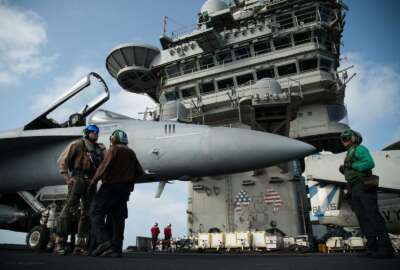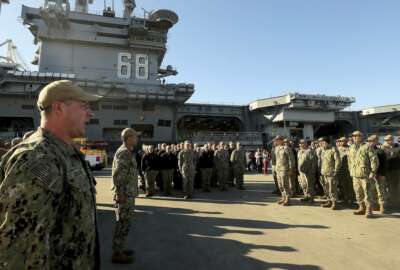
Navy launches six more ‘tech bridges’ to connect local innovators with Defense funding
The long-term vision is to reduce friction in the Navy's innovation ecosystem. In the meantime, it may also help keep some of its smallest and most vital suppliers...
The Defense Department has proven it can get money out the door to contractors quickly during a global pandemic — in some cases, even more quickly than in normal times. But acquisition officials are still very worried about the impact on the smaller suppliers the military can’t afford to lose.
To help solve that challenge, the Department of the Navy (DON) is planning a dramatic acceleration in Small Business Innovative Research contracts: $250 million over the next 90 days. But connecting a huge pool of dollars with a huge pool of vendors in such a short amount of time only works if a small company in Rhode Island can quickly connect with a naval warfare center in Southern California.
Navy officials believe they’ve created a better way to do that sort of thing. Late last year, the DON’s NavalX program opened a half dozen “tech bridges” across the country. The idea is to connect the local innovation hotspots that already exist in the Navy and Marine Corps with one other — and with the Pentagon — to share their technology needs, innovations and best contracting practices.
On Tuesday, officials announced six more: Three in California, and one each in D.C., southern Maryland and Virginia’s tidewater region.
Over the longer-term, the objective is to make sure the Navy’s research hotspots can operate as an integrated network and not separate silos that duplicate each other’s work.
In the shorter-term though, the bridges are extremely useful for prioritizing and directing those SBIR funds, said James Geurts, the assistant secretary of the Navy for research, development and acquisition.
Read more: Defense News
“I’ve challenged the SBIR team to double the amount of awards, and our ability to do that smartly is directly tied to how good a network we have,” he said. “It’s directly tied to how effectively we can communicate to that network, what our needs are, what their opportunities are, and our ability to quickly assess them. If we do that, that’s starting to let us measure this based on mission outcomes, not just activity measures.”
Bridges mostly procedural so far
By “activities,” Geurts is referring to the fact that the tech bridges, in the handful of months they’ve been up and running, have mostly been used to share best practices between the Navy’s existing warfare centers and the companies and academic institutions in their local communities.
So far, they’ve been mostly procedural — for instance, whether and how to use new flexibilities Congress has added to the Defense acquisition system over the course of the last several years of National Defense Authorization Acts.
Thanks to the “bridges,” the NavalX program has been able to develop a single handbook for how to make use of the other transaction authorities (OTAs) Congress expanded in 2016, rather than leaving various commands and warfare centers to figure it out for themselves.
It’s also connected those centers to a new Center for Adaptive Warfighting, which aims to train the acquisition workforce on how to use OTAs and other rapid acquisition tools.
“For our own team, when people first come to work for us, we ask them, ‘If you were given a new project and you wanted to do something more agile or work with new tools, would you know how to get started?’ And it’s only roughly 30% of our workforce,” said Cmdr. Sam Gray, the director of the tech bridge program. “If they’ve gone through the training program, it’s up above 90%.”
The tech bridge program has spent about $45 million so far; Gray said most of that has been used to identify common SBIR topic areas amongst the first six bridge sites the Navy began setting up last September. A smaller pool of money has been used as seed funding to get new bridges up and running, but officials said those centers will need to figure out ways to run under their own steam: they’ll cease to exist if they don’t find ways to become self-sustaining in the next few years.
Read more: Technology News
So far, the bridges have been sponsored by existing Navy warfare centers, mostly because those commands tend to have existing relationships with industry and academia, and are already working on innovation efforts like prize challenges within their local technology ecosystems.
Tuesday’s announcement included the first deviation from that trend: A new bridge at the Naval Postgraduate School in Monterey, Calif.
“The vision is to connect our unique students and faculty to provide the tech bridge network a variety of potential partnerships across all five warfighting domains,” said Chris Manuel, the director of the new Central Coast Tech Bridge. “We plan to leverage our four world-class schools that oversee 77 masters and 16 doctoral programs and our Camp Roberts experimentation site, because we have cleared airspace for autonomous vehicle testing there also. But we also plan to partner with our non-traditional innovation partners throughout the region to deepen our cyber, space and oceanographic capabilities.”
More opportunities for site bridges
The Navy wants to continue expanding the network, and officials say they’re looking for more opportunities to site bridges wherever they make sense – but not in spots where sister services or other Defense agencies have already started similar efforts in local communities or communities of interest.
“There’s a fairly well-known network of what I’d call ‘rebels’ across the DoD,” Geurts said. “This is not an us-versus-them project where we’re competing to see who’s got the cooler innovation thing. The intent is to find the best performers and the best technology areas to link into, and only create something new in an area where we need to. There’s a kindred spirit – we already do joint SBIR across the services. This is all about creating the platform for us to get together, and that platform is not service-specific.”
Officials weren’t able to cite examples of any new products or services the bridges have delivered to the fleet, since even the first round of sites has only been up and running for a few months.
But Geurts said the ultimate objective is to reduce the “organizational distance” a new idea has to travel before it turns into a deliverable product.
“In the past, one of our challenges has been that without a centralized or a collaborative node, the distance between a worker in a naval shipyard and an SBIR program at the Office of Naval Research is pretty large. It crosses many different funding streams, many different organizational streams and cultures, and I wouldn’t expect those two communities to know how to communicate effectively to each other,” he said. “We may not know that an exoskeleton company in Utah could solve a shipyard problem in Portsmouth. So this is really all about exposing and leveraging opportunity.”
Copyright © 2025 Federal News Network. All rights reserved. This website is not intended for users located within the European Economic Area.
Jared Serbu is deputy editor of Federal News Network and reports on the Defense Department’s contracting, legislative, workforce and IT issues.
Follow @jserbuWFED
Related Stories






